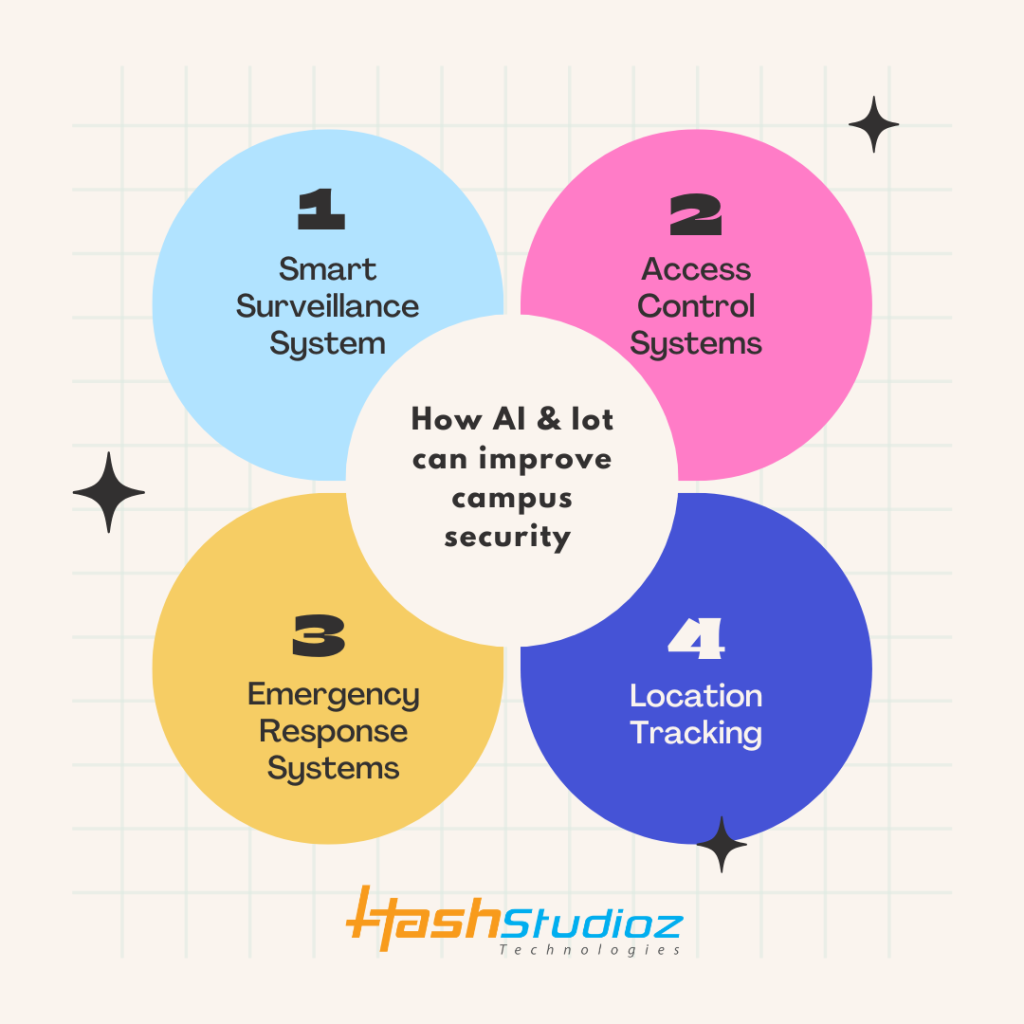In the era of technological advancement, educational institutions aim to improve campus security and streamline attendance tracking. A report by the National Center for Education Statistics (NCES) shows that over 70% of U.S. K-12 schools use security technology. The global market for attendance tracking systems is projected to grow at a rate of 16.6% from 2021 to 2028. This growth highlights the increasing demand for tech-driven solutions in both security and administrative processes. A key factor in this change is the use of the IoT & AI.
These technologies enable smarter campuses with better security and easier attendance tracking, creating safer and more efficient environments for students and staff.
Table of Contents
1. Understanding IoT and AI in Educational Institutions
Before exploring specific use cases, let’s define IoT and AI and their application in educational environments.
What is IoT (Internet of Things)?
The Internet of Things (IoT) is a network of physical devices connected to the internet. These devices collect and exchange data without requiring direct human intervention.
In an educational setting, IoT devices include security cameras, door sensors, wearable devices, and smart attendance systems. The data from these devices is analyzed to improve operations, security, and campus management.
What is AI (Artificial Intelligence)?
Artificial Intelligence simulates human intelligence in machines designed to think, learn, and perform tasks that typically require human involvement. In education, AI can process and analyze data from IoT devices, predict patterns, and improve student safety and attendance tracking.
2. Enhancing Campus Security with IoT and AI
Campus security is a top priority for educational institutions. With IoT and AI, schools can monitor security in real-time, prevent unauthorized access, and respond quickly to emergencies.

Smart Surveillance Systems
IoT-powered surveillance systems monitor campus areas 24/7. These systems use internet-connected cameras, which security personnel can access remotely.
AI enhances these cameras with facial recognition, identifying unauthorized individuals. For example, the University of Arizona uses IoT-based cameras and smart lighting to monitor high-risk areas. AI analyzes camera data to detect suspicious behavior or individuals in restricted zones. The system can trigger alarms and send alerts to security, improving response times.
Access Control Systems
Traditional security systems use keys or ID cards for access. IoT-enabled systems, however, use biometric sensors or RFID tags to grant access. These systems provide real-time data on who enters or exits specific campus areas.
Emergency Response Systems
In emergencies like fires or active shooter situations, immediate action is crucial. IoT devices such as smoke detectors and motion sensors can detect threats and alert authorities right away.
Location Tracking
Tracking individuals’ movement enhances security. IoT devices, such as wearable GPS trackers and smart badges, can be used by students and staff. During security incidents, these devices help pinpoint individuals’ locations quickly.
3. Revolutionizing Student Attendance Tracking
Accurate attendance tracking is critical for academic success and campus management. Traditional attendance methods like roll calls are time-consuming and error-prone. IoT and AI offer more efficient solutions for real-time, automated attendance.
IoT-based Attendance Systems
IoT systems automate attendance tracking using RFID tags, Bluetooth, or facial recognition. Students either use ID cards with embedded RFID tags or their smartphones to check in automatically when entering a classroom.
At Auburn University, IoT technology tracks student attendance using Bluetooth beacons. When a student enters the classroom, their device communicates with the beacon, automatically marking attendance.
AI-powered Data Analysis
Once attendance data is collected, AI analyzes it. AI can identify patterns like frequent absences or specific times when attendance drops. This data helps teachers and administrators address attendance issues.
AI can also detect anomalies, like students marking attendance for others. By providing real-time insights, AI helps educators make informed decisions.
Integration with Educational Apps
Educational apps manage student records and communication. Integrating IoT and AI into these apps streamlines attendance management. AI can send alerts to students and parents about attendance problems and remind them of upcoming classes.
4. Benefits of IoT and AI in Campus Security and Attendance Tracking
Increased Security and Safety
IoT and AI technologies make campuses safer. Real-time monitoring, intelligent surveillance, and predictive AI models help identify potential threats early, reducing risks.
Improved Efficiency
IoT and AI automate tasks like attendance tracking and security monitoring, saving time and reducing errors. Staff can focus on more important duties while technology handles routine activities.
Cost Savings
While initial investments in IoT and AI can be high, the long-term savings are substantial. Automated attendance tracking reduces administrative costs, and AI-driven security systems prevent costly security breaches.
Enhanced Student Experience
Smart attendance systems and improved security provide a better campus experience. IoT and AI ensure academic and security needs are addressed more efficiently, benefiting both students and staff.
5. Implementing IoT and AI Solutions with HashStudioz
Partnering with HashStudioz allows educational institutions to leverage advanced IoT development to create secure, efficient, and connected campuses. Our expertise in implementing IoT-based solutions, such as smart surveillance and attendance systems, ensures a seamless integration that enhances both security and operational efficiency.
In addition, HashStudioz specializes in AI development, offering innovative AI-powered tools that improve campus management. From intelligent security systems to predictive analytics for attendance, we help institutions optimize their processes and make data-driven decisions.
Moreover, our education data analytics services provide actionable insights into student behavior, attendance patterns, and overall campus performance, empowering educators to take proactive measures for improved outcomes.
Contact us today to explore how HashStudioz can help transform your campus with innovative technology solutions tailored to your specific needs!
Conclusion
Integrating IoT and AI into campus security and attendance tracking systems can revolutionize educational environments. These technologies enhance security, streamline administrative tasks, and provide real-time insights into student attendance patterns. Schools embracing these innovations will be better equipped to address modern campus management challenges, offering a safer and more efficient learning environment.
To learn more about implementing IoT and AI on your campus, reach out to HashStudioz and take the first step toward a smarter, more secure educational experience.

